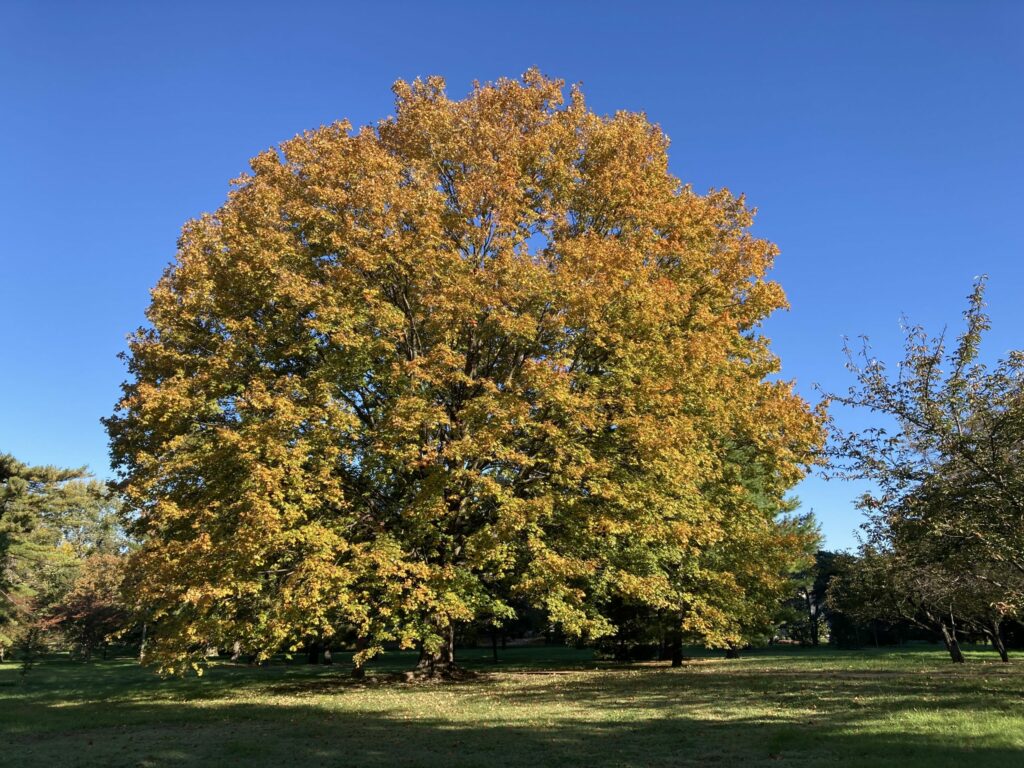By: Mark Halpin, Forestry Manager
Acer saccharum, Sugar Maple, along with the Giant Sequoia, the White Oak and the White Pine, is one of the great arboreal icons of North America. Its leaf is the national symbol of Canada, and when it has turned color, it is perhaps the most definitive symbol of the fall season. Red Maple is far and away more popular in the planted landscape, being smaller and more versatile, but even its glorious crimson foliage seems lackluster next to a prime Sugar Maple in fall. Yellows and oranges are the most prominent colors you will see in its leaves, but there is often just enough of a tinge of anthocyanin (the compound that causes red and purple fall color) to push these hues into different directions – scarlet, dusky gold, even pink on exceptional specimens.
Unlike some trees, the leaves of the Sugar Maple have the quality of being nearly translucent in fall. When sunlight penetrates the canopy, it causes the leaves to “glow” like the paper of a Japanese lantern. But even on a completely overcast day they are no less stunning, the leaves seeming to burn with a light all their own against the grey sky. For a tree that can exceed 100 feet in both height and spread in the right conditions, it is a stunning show. It is easy to become so transfixed under the illuminated canopy of one of these trees that appointments may be missed, troubles forgotten, and the ceaseless chattering of the mind silenced by awe.
Sugar Maple is often seen in parks, or large lawns in old neighborhoods, but it is not a common yard or street tree. Not a pioneer species like the more common Red and Silver Maples, it is slow-growing, intolerant of pollution and poor soils, and gets too large for most urban and suburban sites. This is just as well, for seeing a stunted member of this species is like seeing a Bald Eagle in a cage – glory tinged with sadness. It should be allowed to spread its vast crown in every direction. For sites large enough to accommodate this, it sits alongside the White Oak as shade tree par excellence.
Of course any discussion of Sugar Maple would be incomplete without a mention of that heavenly nectar, without which pancakes and waffles would be scarcely edible – maple syrup. Other maples can be tapped for syrup, but other than Black Maple (Acer nigrum, sometimes considered a subspecies of Sugar Maple) all of them require more sap (Silver Maple syrup requires 10 times more) and yield a poorer product. While the similar (though inferior) birch syrup is traditional in Russia, most early European settlers of North America had no knowledge of tree syrup and learned the art of maple tapping from the continent’s Indigenous peoples (let’s pause and thank). Maple syrup is superior to sugar in nearly every way, being rich in antioxidants, riboflavin, zinc, magnesium, calcium and potassium, and having a lower glycemic index. And of course it tastes better, too. ( And it’s not just for breakfast – try it mixed with whiskey as the Canadians do, on a peanut butter sandwich at lunchtime, or straight from the bottle when no one’s looking. In American Indian cuisine it was often added to meat. Ask yourself – when have you ever gotten maple syrup on something accidentally and been upset about it?)
Now go get yourself a maple donut, find a nice big Sugar Maple in a park somewhere and take a few minutes to yourself under its glowing canopy. Think about how lucky we are to live in the native range of this glorious champion of autumn, and all of the blessings it bestows.
Above: A mature Sugar Maple – note that this is a bad year for fall color, and it still looks good!
Below: The fiery glow, the very emblem of fall!





